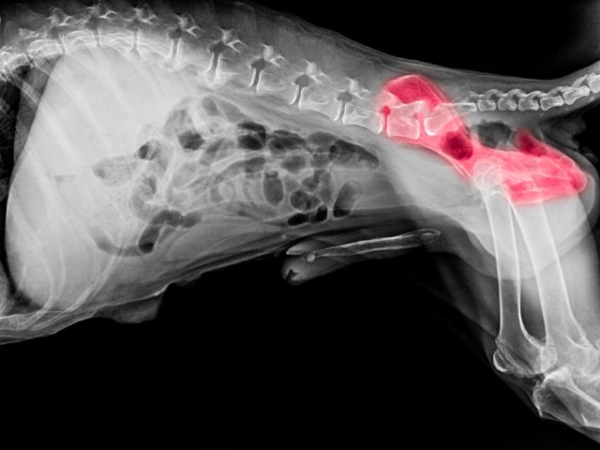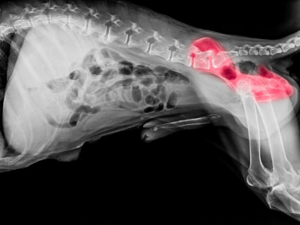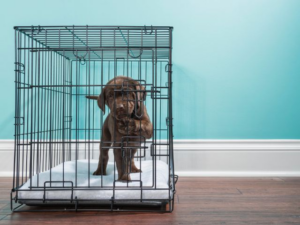Ear cropping in dogs is a controversial practice that involves the surgical removal of a significant portion of a dog’s ear flaps, known as the pinnae.
The main motivation behind ear cropping is often rooted in breed standards or aesthetic preferences, with some dog owners and breeders considering upright ears to be more desirable for certain breeds. However, the practice of ear cropping has faced criticism from animal welfare organizations, veterinarians, and the general public.
In recent years, several countries and jurisdictions have implemented regulations and restrictions on ear cropping, reflecting a growing recognition of the ethical concerns associated with the practice.
In this article, we discuss the advantages and disadvantages of the ear cropping process.
Click here to read about common Rottweiler health problems.
Click here to read up on dog dental care.
What is Dog Ear Cropping?
Ear cropping in dogs involves the amputation (removal) of a large portion (often up to 50%) of the pinnae of a dog’s ears [1]. The pinnae (ear flaps) are the visible, outer part of the ears, and may be floppy or stand straight upwards from the head. The remaining portion of the pinnae, left in-situ after the cropping procedure, is then “trained” to stand straight upwards from the head through a process known as “taping”.
Taping involves attaching a cardboard or wooden splint (providing an upright, hard surface) to the remaining portion of the ear pinnae for several weeks or months (typically around 8 weeks) following ear cropping, with the aim of encouraging the ears to stand upright, rather than flopping over. Over time, the cropped ears become permanently set in their new upright position and the splint is then removed.
Like tail docking, ear cropping practices originated as a means of decreasing the likelihood of ear injuries occurring in dogs used for fighting and hunting purposes. Today, it is widely recognised that cropping provides zero medical benefit for dogs, and is effectively a cosmetic surgical procedure undertaken to subjectively improve a dog’s appearance in the eyes of some breeders and owners.
Some dog breeds are more likely to be seen with cropped ears than others. One recent study conducted in the United Kingdom found that certain breeds of purebred dogs are significantly more likely to have cropped ears compared to the canine population in general, including American and other Bulldogs, Dobermanns, Cane Corsos and other mastiffs [3].
The American Pit Bull terrier may also be seen relatively commonly with cropped ears. Generally, dog breeds commonly used as guard dogs appears to be overrepresented. Ear cropping appears to be rare in many other breeds [3].
Shockingly, many people are not aware that dogs with unnaturally short tails and ears may have undergone a surgical procedure. One recent study found that 42% of the surveyed population instead believed that the short, erect ears and stumpy tails of these dogs were due to genetic factors rather than cropping and tail docking [2]. This shows a worrying lack of awareness in the general population with regards to cropping practices.
Why Do Some People Crop Rottweilers’ Ears?
The saddest fact about ear cropping is that breeders and dog owners who choose to undertake this procedure often do so from a place of misinformation and myth.
The truth – despite what you may have heard – is that there is zero benefit to cropping a Rottweiler’s ears, or any other dog breed for that matter.
Some breeders and owners also elect to have the ear cropping process carried out due to a personal preference for the appearance of dogs with cropped ears. By default, a Rottweiler’s ears are floppy, and do not stand straight upwards. Some individuals may find these natural ears unattractive and prefer their Rottweiler’s ears to appear smaller and more upright.
Evidence suggests that, as a society, we place greater importance on a dog’s appearance than on their personality and breed traits, resulting in a breeding industry that is largely appearance-driven [2].
As such, a Rottie’s ears are most likely to be cropped due to the personal visual preferences of the human breeder or owner.
The best way that you can help society to take a stand on discouraging the practice of ear cropping is to avoid purchasing a Rottweiler puppy with cropped ears. Once the demand for dogs with cropped ears is removed, the supply chain of these dogs will reduce accordingly.
Improved Appearance – For Some
As mentioned, some individuals consider uncropped ears to be unattractive, and elect to have the ear cropping process undertaken for cosmetic reasons.
Supporters of ear cropping may additionally argue that by straightening the ears, the dog more closely fits a historically desirable appearance for that particular breed. This is equally the justification provided in many cases of tail docking.
Prevent Wounds in Dog Fights
It is certainly true that if a dog has smaller ears, there will be less chance of an injury occurring to the ears during dog fighting. However, dog fighting is now (thankfully) widely illegal and recognised to be highly immoral, with severe health and welfare consequences for the dogs involved.
Given that we live in a society that quite rightly does not allow dog fights for entertainment purposes, ear cropping is a practice that firmly belongs in history books.
 Myth Number One: Improved Hearing
Myth Number One: Improved Hearing
Some people mistakenly believe that erect ears allow more sound to reach the inner ear, resulting in improved hearing. This belief is not supported by science, and there is a clear lack of evidence in support of this myth.
In fact, the ear pinnae are known to be important for assisting with hearing acuity, acting like radar to amplify sound. So it’s far more likely that the reverse is true, and that dogs with cropped ears may have a reduced hearing ability.
Myth Number Two: Cropping will Reduce Ear Infections
It is a common misconception that cropping ears can decrease the likelihood of an ear infection occurring. Again, there is no evidence to support this myth.
Bacterial and yeast ear infections in dogs occur due to a complex combination of factors, involving the dog’s immune defences, the environment within the ear (including heat and humidity levels), and the number of bacteria or yeast present. It is not possible to prevent ear infections simply by having your dog’s ears cropped.
If it was, vets would be cropping ears left, right and centre, as ear infections are one of the most common problems seen in first-opinion GP veterinary practice!
So, the take home message here? Cropping a dog’s ears will do absolutely nothing in terms of preventing ear infections for your dog.
What are the Disadvantages of Dog Ear Cropping?
Immense Pain
Cropping is an unnecessary procedure that causes significant unnecessary pain. In fact, it is believed to be extremely painful. This is definitely a fact that should be taken into consideration by any owner or would-be owner who is considering having their dog’s ears cropped.
Potential for Heavy Blood Loss
Ears are very vascular, meaning they have a plentiful blood supply. So, when you cut ears they tend to bleed a lot. If your dog is undergoing ear cropping at a veterinary clinic, the vet will take great care to prevent and stem bleeding as far as possible, but there is certainly still a risk of hemorrhage during and after the procedure.
If the procedure is being carried out illegally at home by a dog breeder or owner, the risk of heavy blood loss is far greater. This is because the pet is not under general anesthetic, so movement and increased blood pressure (a result of stress and pain) during the procedure raise the potential for bleeding.
Behavioral Problems
Cropping a dog’s ears has the potential to have long-lasting negative effects on the pet’s personality, social development and willingness to interact with humans. Furthermore, having the ears taped can cause ongoing discomfort, which can result in a puppy developing long-lasting ear pain and sensitivity around the ears being handled or touched.
Risk of Infection
According to the American Veterinary Medical Association, this unnecessary procedure comes with a sizeable risk of serious infection when it is undertaken outside of a veterinary clinic in a less-than-sterile environment. This risk is much lower when cropping is carried out at a veterinary clinic, however serious infections can certainly still occur resulting in additional pain, discomfort and costs.
Illegal in Many Regions
As we will discuss below under “Is it Legal to Crop a Dog’s Ears?”, ear cropping is illegal in many geographical regions, including most of Europe, Australia and several American states. This means that individuals who take it upon themselves to carry out this procedure can face serious legal consequences.
Waste of Time and Money
Ear cropping has no proven benefits and many risks and downsides. As such, spending time and money on cropping and taping a dog’s naturally floppy ears can at best be considered a waste of resources, and at worst a serious welfare concern.
Like tail docking, ear cropping should only be undertaken on the direct advice of a veterinary surgeon, where there is a genuine medical reason that the procedure needs to be carried out.
 What is the Dog Ear Cropping Procedure?
What is the Dog Ear Cropping Procedure?
The ear cropping procedure is usually performed between 6 and 12 weeks old [3]. Ear cropping is a surgical procedure, involving the amputation of a portion of the ears, and should only ever be undertaken by a qualified veterinary surgeon under general anesthesia.
During the ear cropping procedure, up to 50% of the floppy part of the ears (the pinnae) is removed. A line may be marked on each ear as a guide, and the ears cut in a symmetrical manner using surgical scissors. Bleeding is addressed using sutures or cautery.
If ear cropping is to be undertaken, it should only ever be carried out as above, by a qualified veterinary surgeon. The tragic reality however is that many breeders and dog owners carry out ear cropping at home, without any veterinary input, in an unsterile manner and with minimal or no pain relief provided to the dog.
Is it Legal to Crop a Dog’s Ears?
Cropping for cosmetic purposes is illegal in Canada, Australia and most of Europe. Cropping was made illegal in the United Kingdom in 2006. Although cropping is illegal in Romania, Hungary, Bulgaria, Serbia, Spain, Poland and Ireland, it has been noted that a significant number of dogs with cropped ears in the UK have been imported from these countries [3].
If you’re US-based, you should be aware that it is illegal to crop a dog’s ears in Connecticut, Maryland, New Hampshire, New York, and Pennsylvania unless undertaken by a licensed vet while the dog is under anesthetic. Furthermore, Maryland law states that the ear cropping must be appropriate for the animal.
The American Kennel Club and Ear Cropping
The American Kennel Club (AKC) exhibits a shockingly outdated and poorly informed policy with regard to ear cropping, and a statement published by the AKC in 2008 appears to effectively encourage the ear cropping procedure in certain dog breeds. This policy is entirely out of line with modern day veterinary medical knowledge, and incongruent with practically all medical research relating to ear cropping.
AKC rules do not prohibit ear cropping and list cropped ears as being acceptable under several breed standards; for example, AKC Doberman Pinscher breed standards advise that Doberman Pinschers ear’s should be “normally cropped and carried erect”.
Likewise, the Miniature Pinscher is described within the breed standard as having “ears set high, standing erect from base to tip. May be cropped or uncropped”.
The AKC do not advocate for cropping Rottweiler ears, advising instead that these should be “of medium size, pendant and triangular in shape”.
 Do Dogs with Cropped Ears Act More Aggressive?
Do Dogs with Cropped Ears Act More Aggressive?
Interestingly, survey evidence has shown that dogs with cropped ears are generally considered to be ‘more aggressive, more dominant [and] less playful’ than dogs with natural floppy ears [2].
What’s more, this isn’t just hearsay; there’s truth to it. Cropping a puppy’s ears can have permanent, disastrous effects on how he or she will interact with their family and the other humans in their life.
The pain associated with this unnecessary procedure (typically carried out at a highly impressionable developmental age) is not easily forgotten, and negative cognitive biases (unhelpful learned associations) may form, for example linking interaction with humans and the onset of pain.
It is also interesting to note that the same survey, which investigated the general public’s perceptions in relation to ear cropping, found that owners of dogs with cropped ears were perceived as being ‘more aggressive, more narcissistic, less playful, less talkative and less warm’ compared to owners of other dogs with a natural appearance [2].
Perhaps if more owners and breeders were aware of this perception, the practice of ear cropping might finally be resigned to the history books, where it belongs.
Final Words on Cut Ears
Considering the mounting evidence against ear cropping and the ethical concerns surrounding the procedure, it is crucial for owners and breeders to be aware of the negative implications it can have on a dog’s behavior and the perception of both the dog and its owner.
By understanding the potential long-term consequences and the negative societal perceptions associated with ear cropping, there is an opportunity to shift towards more humane and responsible practices in dog breeding.
It is our collective responsibility to prioritize the well-being and welfare of dogs, promoting practices that enhance their quality of life rather than subjecting them to unnecessary procedures that can have lasting negative effects.
By raising awareness and encouraging informed decision-making, we can work towards a future where ear cropping is consigned to the history books, allowing dogs to be valued and loved for their natural appearance and temperament.
Interested in finding out whether spaying and neutering is beneficial for your canine? Read here.
Fing out what shots your dog needs annually.
Reference List:
[1] Mills, K.E., Von Keyserlingk, M.A.G. and Niel, L. A review of medically unnecessary surgeries in dogs and cats. Journal of the American Veterinary Medical Association. (2016)
[2] Mills, K.E., Robbins, J. and Von Keyserlingk, M.A.G. Tail Docking and Ear Cropping Dogs: Public Awareness and Perceptions. PLOS One. (2016)
[3] Norris, L.J., Pinchbeck, G.L., Noble, P.J.M. and Radford, A.D. Dogs with cropped ears in the UK: A population-based study using electronic health records. Veterinary Record. (2023)



 Myth Number One: Improved Hearing
Myth Number One: Improved Hearing What is the Dog Ear Cropping Procedure?
What is the Dog Ear Cropping Procedure? Do Dogs with Cropped Ears Act More Aggressive?
Do Dogs with Cropped Ears Act More Aggressive?










